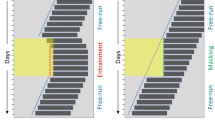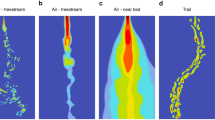Abstract
To test the idea that caffeine might induce changes in gene expression in the honeybee brain, we contrasted the transcriptional profiles of control and caffeine-treated brains using high-throughput cDNA microarrays. Additional quantitative real-time PCR was performed on a subset of eight transcripts to visualize the temporal changes induced by caffeine. Genes that were significantly upregulated in caffeine-treated brains included those involved in synaptic signaling (GABA:Na symporter, dopamine D2R-like receptor, and synapsin), cytoskeletal modifications (kinesin and microtubule motors), protein translation (ribosomal protein RpL4, elongation factors), and calcium-dependent processes (calcium transporter, calmodulin-dependent cyclic nucleotide phosphodiesterase). In addition, our study uncovered a number of novel, caffeine-inducible genes that appear to be unique to the honeybee. Time-dependent profiling of caffeine-sensitive gene expression shows significant upregulation 1 h after treatment followed by moderate downregulation after 4 h with no additional changes occuring after 24 h. Our results provide initial evidence that the dopaminergic system and calcium exchange are the main targets of caffeine in the honeybee brain and suggest that molecular responses to caffeine in an invertebrate brain are similar to those in vertebrate organisms.
Similar content being viewed by others
References
Beggs K. T., Hamilton I. S., Kurshan P. T., Mustard J. A., Mercer A. R. (2005) Characterization of a D2-like dopamine receptor (AmDOP3) in honeybees, Apis mellifera. Insect Biochem. Mol. Biol. 35, 873–882.
Carillo R. and Gibson G. (2002) Unusual genetic architecture of natural variation affecting drug resistance in Drosophila melanogaster. Genet. Res. 80, 205–213.
Ein-Dor L., Kela I., Getz G., Givol D., and Domany E. (2005) Outcome signature genes in breast cancer: is there a unique set? Bioinformatics 21, 171–178.
Grozinger C. M., Sharabash N. M., Whitfield C. W., and Robinson G. E. (2003) Pheromone-mediated gene expression in the honey bee brain. Proc. Natl. Acad. Sci. U. S. A. 100(Suppl. 2), 14,519–14,525.
Honey Bee Genome Project (HBGP) (2004) www.nature.com/nsu/040105/040105-7.html
Iwata S. I., Hewlett G. H., Ferrell S. T., Kantor L., and Gnegy M. E. (1997) Enhanced dopamine release and phosphorylation of synapsin I and neuromodulin in striatal synaptosomes after repeated amphetamine. J. Pharmacol. Exp. Ther. 283(3), 1445–1452.
Kothapalli R., Yoder S. J., Mane S., and Loughran T. P. Jr. (2002) Microarray results: how accurate are they? BMC Bioinformatics 3, 22–31.
Kopf S. R., Melani A., Pedata F., and Pepeu G. (1999) A denosine and memory storage: effect of A(1) and A(2) receptor antagonists. Psychopharmacology (Berl.) 146, 214–219.
Korkotian E. and Segal M. (1999) Release of calcium from stores alters the morphology of dendritic spines in cultured hippocampal neurons. Proc. Natl. Acad. Sci. U. S. A. 96, 12,068–12,072.
Kucharski R. and Maleszka R. (1998) Arginine Kinase is highly expressed in the compound eye of the honeybee, Apis mellifera. Gene. 211, 343–349.
Kucharski R. and Maleszka R. (2002) Evaluation of differential gene expression during behavioral development in the honeybee using microarrays and northern blots. Genome Biol. 3, Research 7.1–7.9.
Kucharski R. and Maleszka R. (2003) Transcriptional profiling reveals multifunctional roles for transferrin in the honeybee (Apis mellifera). J. Insect Sci. 3, 27–36.
Lindskog M., Svenningsson P., Pozzi L., Kim Y., Fienberg A. A., Bibb J. A., et al. (2002) Involvement of DARPP-32 phosphorylation in the stimulant action of caffeine. Nature 418, 774–778.
Lorist M. M. and Tops M. (2003) Caffeine, fatigue, and cognition. Brain Cogn. 53, 82–94.
Miklos G. L. G. and Maleszka R. (2004) Microarray reality checks in the context of a complex disease. Nat. Biotechnol. 22, 615–621.
Mirnics K. (2001) Microarrays in brain research: the good, the bad and the ugly. Nat. Rev. Neurosci. 2, 444–447.
Pfaffl M. W. (2001) A new mathematical model for relative quantification in real-time RT-PCR. Nucleic Acids Res. 29, e45.
Pongrac J., Middleton F. A., Lewis D. A., Levitt P., and Mirnics K. (2002) Gene expression profiling with DNA microarrays: advancing our understanding of psychiatric disorders. Neurochem. Res. 27, 1049–1063.
Scott R., Bourtchuladze R., Gossweiler S., Dubnau J., and Tully T. (2002) CREB and the discovery of cognitive enhancers. J. Mol. Neurosci. 19, 171–177.
Schwarzschild M. A., Chen J. F., and Ascherio A. (2002) Caffeinated clues and the promise of adenosine A(2A) antagonists in PD. Neurology 58, 1154–1160.
Stonehouse A. H., Adachi M., Walcott E. C., and Jones F. S. (2003) Caffeine regulates neuronal expression of the dopamine 2 receptor gene. Mol. Pharmacol. 64(6), 1,463–1,473.
Vawter M. P., Barrett T., Cheadle C., Sokolov B. P., Wood W. H. III, Donovan D. M., et al. (2001) Application of cDNA microarrays to examine gene expression differences in schizophrenia. Brain Res. Bull. 55, 641–650.
Walaas S. I., Sedvall G., and Greengard P. (1989) Dopamine-regulated phosphorylation of synaptic vesicle-associated proteins in rat neostriatum and substantia nigra. Neuroscience 29(1), 9–19.
Whitfield C. W., Band M. R., Bonaldo M. F., Kumar C. G., Liu L., Pardinas J. R., et al. (2002) Annotated expressed sequence tags and cDNA microarrays for studies of brain and behavior in the honey bee. Genome Res. 12, 555–566.
Author information
Authors and Affiliations
Corresponding author
Rights and permissions
About this article
Cite this article
Kucharski, R., Maleszka, R. Microarray and real-time PCR analyses of gene expression in the honeybee brain following caffeine treatment. J Mol Neurosci 27, 269–276 (2005). https://doi.org/10.1385/JMN:27:3:269
Received:
Accepted:
Issue Date:
DOI: https://doi.org/10.1385/JMN:27:3:269




